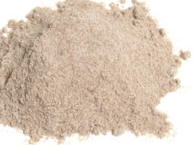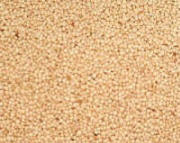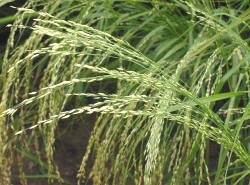Nutritional Values of Teff
Because the seed
is so small, it is not practicable to separate the germ from the husk, so when
making Teff flour, the entire seed is milled and consumed. This results in
richer nutritional values.
It has high levels
of calcium, phosphorus, iron, copper, barium, Potassium and thiamine, contains
all 8 essential amino acids for humans and has lysine levels higher than that of
wheat or barley. Teff is also high in protein, carbohydrates and fibre and
contains no gluten.
Furthermore, its
complex carbohydrates i.e. slowly digestible starches, give it a low glycaemic
index which makes it suitable for diabetics and those wishing to lose
weight as well as endurance athletes. Many believe the superior
performances of Ethiopians in long distance running can be attributed to
the Teff consumed as part of their normal diet, particularly in the form
of injera - a type of flatbread widely eaten in Ethiopia.
Buying and storing
Teff
Although it is
still sometimes difficult to find Teff grains or flour in high street
supermarkets many natural whole-foods stores will stock it. It can also be
bought online from various stockists.
Store it in a
cool, dry area in a sealed container or packet.
Teff in cooking
Teff Grain
 The
grain is gluten free and has a mild, nutty and slightly sweet flavour. The
darker the grain, the more earthy the flavour. The uncooked grain can be
added or substituted for part of the seeds or nuts in recipes and can be
used as a thickener for soups, stews and casseroles. The
grain is gluten free and has a mild, nutty and slightly sweet flavour. The
darker the grain, the more earthy the flavour. The uncooked grain can be
added or substituted for part of the seeds or nuts in recipes and can be
used as a thickener for soups, stews and casseroles.
The cooked grains
can be mixed with other ingredients such as beans or tofu to make burgers or can
be used to make salads similar to Bulgur Wheat. Allow
450ml/15fl.oz of liquid (water or
stock) to cook 100g/4oz Teff grains which
will take about 20 minutes.
Once cooked they
have a slightly sticky consistency which enables them to be moulded or formed
into solid masses once it has cooled, which can be used like polenta.
They can also be
cooked like porridge and make a healthy and nutritious breakfast, especially
when served with sliced fruit.
Teff Flour
 Teff
flour is gluten free however, like many other gluten free flours, it is
necessary to add additional ingredients to create a stable structure when making
leavened yeast based bread. Teff
flour is gluten free however, like many other gluten free flours, it is
necessary to add additional ingredients to create a stable structure when making
leavened yeast based bread.
In other recipes
such as biscuits, cakes, pie crust pastry and pancakes, it can be
substituted for ordinary wheat flour with good results.
Teff Recipes
Teff Gluten Free
Pastry Crust Veg HT CD CBF 15mins
Ethiopian Injera Flatbread Veg CD ACC
20mins plus standing
Herby Pepper Teff Polenta Veg HT ACC 30mins
|


 Teff
has been widely cultivated and used in Ethiopia and Eritrea for centuries
and has also grown in South Africa, India and and Australia. It is a
fine stemmed annual grass characterised by a large crown, many shoots, and a
shallow root system. The plants germinate quickly and are adapted to
environments ranging from drought stress to water logged soil conditions.
Teff
has been widely cultivated and used in Ethiopia and Eritrea for centuries
and has also grown in South Africa, India and and Australia. It is a
fine stemmed annual grass characterised by a large crown, many shoots, and a
shallow root system. The plants germinate quickly and are adapted to
environments ranging from drought stress to water logged soil conditions.
 The
grain is gluten free and has a mild, nutty and slightly sweet flavour. The
darker the grain, the more earthy the flavour. The uncooked grain can be
added or substituted for part of the seeds or nuts in recipes and can be
used as a thickener for soups, stews and casseroles.
The
grain is gluten free and has a mild, nutty and slightly sweet flavour. The
darker the grain, the more earthy the flavour. The uncooked grain can be
added or substituted for part of the seeds or nuts in recipes and can be
used as a thickener for soups, stews and casseroles. Teff
flour is gluten free however, like many other gluten free flours, it is
necessary to add additional ingredients to create a stable structure when making
leavened yeast based bread.
Teff
flour is gluten free however, like many other gluten free flours, it is
necessary to add additional ingredients to create a stable structure when making
leavened yeast based bread.